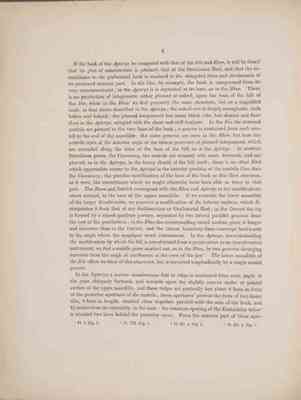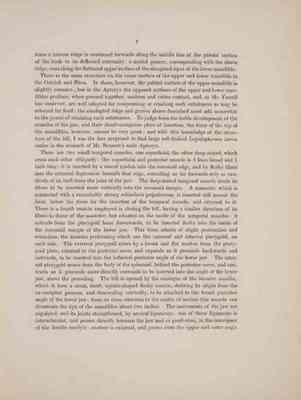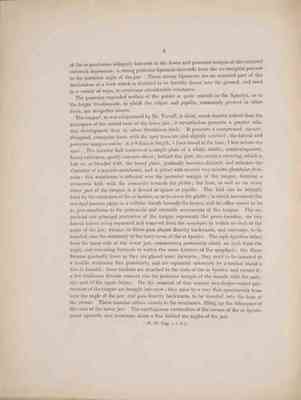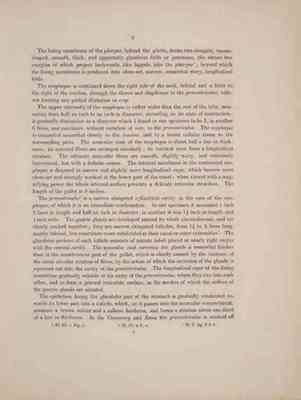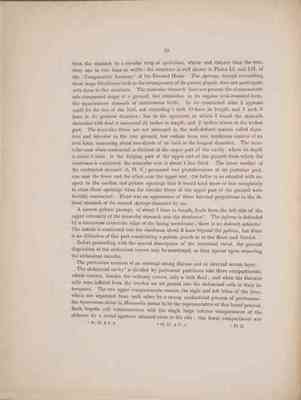Pages
26
6
If the beak of the Apteryx be compared with that of the Ibis and Rhea, it will be found that its plan of construction is precisely that of the Struthious Bird, and that the resemblance to the grallatorial beak is confined to the elongated form and slenderness of its produced anterior part. In the Ibis, for example, the beak is compressed from its very commencement ; in the Apteryx it is depressed at its base, as in the Rhea. There is no production of integument, either plumed or naked, upon the base of the bill of the Ibis, while in the Rhea1 we find precisely the same structure, but on a magnified scale, as that above described in the Apteryx ; the naked cere is deeply emarginate, both before and behind ; the plumed integument has many black setae, but shorter and finer than in the Apteryx, mingled with the short and stiff feathers. In the Ibis the external nostrils are pierced in the very base of the beak ; a groove is continued from each nostril to the end of the mandible ; the same grooves are seen in the Rhea, but here the nostrils open at the anterior angle of the lateral processes of plumed integument, which are extended along the sides of the base of the bill, as in the Apteryx. In another Struthious genus, the Cassowary, the nostrils are situated still more forwards, and are pierced as in the Apteryx, in the horny sheath of the bill itself ; there is no other Bird which approaches nearer to the Apteryx in the anterior position of the nostrils than does the Cassowary ; the peculiar modification of the base of the beak in this Bird obscures, as it were, the resemblance which we might otherwise have been able to trace in that part. The Emeu and Ostrich correspond with the Rhea and Apteryx in the modifications above noticed, in the base of the upper mandible. If we examine the lower mandible of the larger Struthionidae, we perceive a modification of its inferior surface, which distinguishes it from that of any Gallinaceous or Grallatorial Bird ; in the Ostrich the tip is formed by a raised quadrate portion, separated by two lateral parallel grooves from the rest of the gnathotheca ; in the Rhea the corresponding raised median piece is longer and narrower than in the Ostrich, and the lateral boundary-lines converge backwards to the angle where the symphysis menti commences. In the Apteryx, notwithstanding the modification by which the bill is transformed from a granivorous to an insectivorous instrument, we find a middle piece marked out, as in the Rhea, by two grooves diverging forwards from the angle of confluence of the rami of the jaw2. The lower mandible of the Ibis offers no trace of this character, but is traversed longitudinally by a single mesial groove.
In the Apteryx a narrow membranous fold or ridge is continued from each angle of the gape obliquely forwards and inwards upon the slightly convex under or palatal surface of the upper mandible, and these ridges are gradually lost about 8 lines in front of the posterior apertures of the nostrils ; these apertures3 present the form of two linear slits, 4 lines in length, situated close together, parallel with the axis of the beak, and 4 1/2 inches from its extremity, in the male : the common opening of the Eustachian tubes4 is situated two lines behind the posterior nares. From the anterior part of these aper-
1 Pl. I. Fig. 3. 2Pl. VII. Fig. 7. 3Pl. III .a. Fig. 1. 4Pl. III. b. Fig. 1.
27
7
tures a narrow ridge is continued forwards along the middle line of the palatal surface of the beak to its deflected extremity : a mesial groove, corresponding with the above ridge, runs along the flattened upper surface of the elongated myxa of the lower mandible.
There is the same structure on the inner surface of the upper and lower mandible in the Ostrich and Rhea. In these, however, the palatal surface of the upper mandible is slightly concave ; but in the Apteryx the opposed surfaces of the upper and lower mandibles produce, when pressed together, uniform and entire contact, and, as Mr. Yarrell has observed, are well adapted for compressing or crushing such substances as may be selected for food : the coadapted ridge and groove above described must add somewhat to the power of retaining such substances. To judge from the feeble development of the muscles of the jaw, and their disadvantageous place of insertion, the force of the nip of the mandibles, however, cannot be very great ; and with this knowledge of the structure of the bill, I was the less surprised to find large soft-bodied Lepidopterous larvae entire in the stomach of Mr. Bennett's male Apteryx.
There are two small temporal muscles, one superficial, the other deep-seated, which cross each other obliquely : the superficial and posterior muscle is 4 lines broad and 1 inch long : it is inserted by a round tendon into the coronoid edge, and by fleshy fibres into the external depression beneath that edge, extending as far forwards only as twothirds of an inch from the joint of the jaw. The deep-seated temporal muscle sends its fibres to be inserted more vertically into the coronoid margin. A masseter, which is connected with a remarkably strong orbicularis palpebrarum, is inserted still nearer the joint, below the fossa for the insertion of the temporal muscle, and external to it. There is a fourth muscle employed in closing the bill, having a similar direction of its fibres to those of the masseter, but situated on the inside of the temporal muscles : it extends from the pterygoid bone downwards, to be inserted fleshy into the inside of the coronoid margin of the lower jaw. This bone admits of slight protraction and retraction, the muscles performing which are the external and internal pterygoid, on each side. The external pterygoid arises by a broad and flat tendon from the pterygoid plate, external to the posterior nares, and expands as it proceeds backwards and outwards, to be inserted into the inflected posterior angle of the lower jaw. The internal pterygoid arises from the body of the sphenoid, behind the posterior nares, and contracts as it proceeds more directly outwards to be inserted into the angle of the lower jaw, above the preceding. The bill is opened by the analogue of the biventer maxillae, which is here a stout, short, square-shaped fleshy muscle, deriving its origin from the ex-occipital process, and descending vertically, to be attached to the broad posterior angle of the lower jaw : from its close situation to the centre of motion this muscle can divaricate the tips of the mandibles about two inches. The movements of the jaw are regulated, and its joints strengthened, by several ligaments : one of these ligaments is interarticular, and passes directly between the jaw and os quadratum, in the interspace of the double condyle : another is external, and passes from the upper and outer angle
28
8
of the os quadratum obliquely forwards to the lower and posterior margin of the external coronoid depression : a strong posterior ligament descends from the ex-occipital process to the posterior angle of the jaw. These strong ligaments are an essential part of the mechanism of a beak which is destined to be forcibly thrust into the ground, and used in a variety of ways, to overcome considerable resistance.
The posterior expanded surface of the palate is quite smooth in the Apteryx, as in the larger Struthionidae, in which the ridges and papillae, commonly present in other birds, are altogether absent.
The tongue1, as was conjectured by Mr. Yarrell, is short much shorter indeed than the interspace of the united rami of the lower jaw ; it nevertheless presents a greater relative development than in other Struthious birds. It presents a compressed, narrow, elongated, triangular form, with the apex truncate and slightly notched ; the lateral and posterior margins entire : it is 8 lines in length, 4 lines broad at the base, 1 line across the apex. The anterior half consists of a simple plate of a white, elastic, semitransparent, horny substance, gently concave above ; behind this part, the exterior covering, which is lost in, or blended with, the horny plate, gradually becomes distinct, and assumes the character of a mucous membrane, and is pitted with several very minute glandular foramina : this membrane is reflected over the posterior margin of the tongue, forming a crescentic fold, with the concavity towards the glottis ; but here, as well as on every other part of the tongue, it is devoid of spines or papillae. This fold can be brought back by the retractors of the os hyoides, so as to cover the glottis ; in which movement the uro-hyal process plays in a cellular sheath beneath the larynx, and its office seems to be to give steadiness to the protractile and retractile movements of the tongue. The superficial and principal protractor of the tongue represents the genio-hyoideus, its two lateral halves being separated and removed from the symphysis to within an inch of the angle of the jaw, whence its fibres pass almost directly backwards, and converge, to be inserted into the extremity of the bony cornu of the os hyoides. The mylo-hyoideus arises from the inner side of the lower jaw, commencing posteriorly about an inch from the angle, and extending forwards to within the same distance of the symphysis ; the fibres become gradually fewer as they are placed more forwards ; they meet to be inserted at a middle tendinous line posteriorly, and are separated anteriorly by a tendon about a line in breadth : these tendons are attached to the body of the os hyoides, and retract it : a few tendinous threads connect also the posterior margin of the muscle with the anterior part of the upper larynx. On the removal of this muscle two deeper-seated protractors of the tongue are brought into view ; they arise by a very thin aponeurosis from near the angle of the jaw, and pass directly backwards, to be inserted into the base of the cornua. These muscles adhere closely to the membrane, filling up the interspace of the rami of the lower jaw. The cartilaginous extremities of the cornua of the os hyoides curve upwards, and terminate about a line behind the angles of the jaw.
1 Pl. III. Figg. 1 c & 2.
29
9
The lining membrane of the pharynx, behind the glottis, forms two elongate, squareshaped, smooth, thick, and apparently glandular folds or processes, the obtuse free margins of which project backwards, like lappels, into the pharynx1 ; beyond which the lining membrane is produced into close-set, narrow, somewhat wavy, longitudinal folds.
The oesophagus is continued down the right side of the neck, behind and a little to the right of the trachea, through the thorax and diaphragm to the proventriculus, without forming any partial dilatation or crop.
The upper extremity of the oesophagus is rather wider than the rest of the tube, measuring from half an inch to an inch in diameter, according to its state of contraction : it gradually diminishes to a diameter which I found in one specimen to be 3, in another 6 lines, and continues, without variation of size, to the proventriculus. The oesophagus is connected somewhat closely to the trachea, and by a looser cellular tissue to the surrounding parts. The muscular coat of the oesophagus is about half a line in thickness ; its external fibres are arranged circularly ; its internal ones form a longitudinal stratum. The ultimate muscular fibres are smooth, slightly wavy, and reticularly intermixed, but with a definite course. The internal membrane in the contracted oesophagus is disposed in narrow and slightly wavy longitudinal rugae, which become more close-set and strongly marked at the lower part of the canal : when viewed with a magnifying power the whole internal surface presents a delicate reticular structure. The length of the gullet is 9 inches.
The proventriculus2 is a narrow elongated cylindrical cavity in the axis of the oesophagus, of which it is an immediate continuation. In one specimen it measured 1 inch 2 lines in length and half an inch in diameter, in another it was 1 1/2 inch in length and 1 inch wide. The gastric glands are developed around its whole circumference, and are closely packed together ; they are narrow elongated follicles, from 1 1/2 to 2 lines long, mostly bilobed, but sometimes more subdivided at their caecal or outer extremities3. The glandular parietes of each follicle consists of minute tubuli placed at nearly right angles with the central cavity. The muscular coat covering the glands is somewhat thicker than in the membranous part of the gullet, which is chiefly caused by the increase of the outer circular stratum of fibres, by the action of which the secretion of the glands is squeezed out into the cavity of the proventriculus. The longitudinal rugae of the lining membrane gradually subside at the entry of the proventriculus, where they run into each other, and so form a general reticulate surface, in the meshes of which the orifices of the gastric glands are situated.
The epithelium lining the glandular part of the stomach is gradually condensed towards its lower part into a cuticle, which, as it passes into the muscular compartment, assumes a brown colour and a callous hardness, and forms a stratum about one-third of a line in thickness. In the Cassowary and Emeu the proventriculus is marked off
1 Pl. III. e Fig 1. 2 Pl. IV. & V. a 3 Pl. V. fig. 2 & 3.
C
30
10
from the stomach by a circular strip of epithelium, whiter and thinner than the rest' from one to two lines in width : the structure is well shown in Plates LI. and LII. of the 'Comparative Anatomy' of Sir Everard Home. The Apteryx, though resembling these large Struthious birds in the arrangement of its gastric glands, does not participate with them in this structure. The muscular stomach 1 does not present the characteristic sub-compressed shape of a gizzard, but resembles, in its regular oval-rounded form, the membranous stomach of carnivorous birds. In its contracted state it appears small of the size of the bird, not exceeding 1 inch 10 lines in length and 1 inch 3 lines in its greatest diameter ; but in the specimen in which I found the stomach distended with food it measured 2 1/2 inches in length, and 2 inches across at the widest part. The muscular fibres are not arranged in the well-defined masses called digastrici and laterales in the true gizzard, but radiate from two tendinous centres of an oval form, measuring about two-thirds of an inch in the longest diameter. The muscular coat when contracted is thickest at the upper part of the cavity, where its depth is about 3 lines : in the bulging part at the upper end of the gizzard from which the duodenum is continued, the muscular coat is about 1 line thick. the inner surface of the contracted stomach (b, Pl.V.) presented two protruberances at its posterior part, one near the lower and the other near the upper end : the latter is so situated with respect to the cardiac and pyloric openings that it would tend more or less complerely to close those openings when the circular fibres at the upper part of the gizzard were forcibly contracted. There was no appearance of these internal projections in the dilated stomach of the second Apteryx dissected by me.
A narrow pyloric passage, of about 3 lines in length, leads from the left side of the upper extremity of the muscular stomach into the duodenum 2.The pylorus id defended by a transverse crescentic ridge of the lining membrane ; there is not distinct sphincter. The cuticle is continued into the duodenum about 3 lines beyond the pylorus, but there is no dilatation of this part constituting a pyloric pouch as in the Emeu and Ostrich.
Before proceeding with the special description of the intestinal canal, the general disposition of the abdominal viscera may be mentioned, as they appear upon removing the abdominal muscles.
The peritoneum consists of an external strong fibrous and an internal serous layer.
The abdominal cavity 3 is divided by peritoneal partitions into three compartments, which contain, besides the ordinary viscera, only a little fluid ; and when the thoracic cells were inflated from the trachea no air passed into the abdominal cells or their interspaces. The two upper compartments contain the right and left lobes of the liver, which are separated from each other by a strong mediastinal process of peritonium : the ligamentum latum in Mammalia seems to be the representative of this broad process. Each hepatic cell communicates with the single large inferior compartment of the abdomen by a round aperture situated close to the ribs ; this lower compartment was
1 Pl. IV.& V.b. 2. Pl. IV.& V.c. 3. Pl. II
